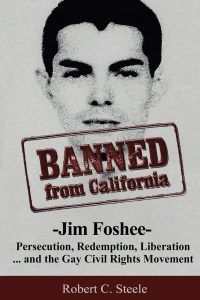Not long ago I was asked to vet a request for use of photos that appeared in my writings at The Tangent Group. The reprint request was from Robert C. Steele for his book Banned from California. Curious about the book, I did a halfhearted web search and didn’t find it. Days later my friend Jerry Gerash told me he was sending me a book about Jim Foshee. “You know who he was, don’t you?” he asked. “Of course,” I said. I know who Jim Fouratt is.

When the book arrived I realized my mistake. Banned from California is subtitled Jim Foshee – Persecution, Redemption, Liberation… and the Gay Civil Rights Movement. But I had no idea why Jerry sent the book until Chapter 33: Gay Coalition of Denver. Jerry, of course, helped found that organization and I’ve helped promote his telling the story of that same group’s Denver Gay Revolt of 1973.
Banned from California is self-published, with all the drawbacks of that limitation: poor photo reproduction (the same vertical line artifact in many of the images), typographical errors (although I’m told these have been corrected), a complete absence of hyphenation, an undistinguished layout. And so I wasn’t particularly eager to pick it up. But I’m glad I did.
Steele draws you in with the first chapter, California Here I Come, taken out of an otherwise chronological context, describing Foshee’s first of many escapes from the confines of religious and heteronormative suffocation in a small Idaho town. “The parishioners at my parents’ churches always ranted and raved and claimed that California was the place where all the queers and fruits were located,” Foshee is quoted, “so I figured that’s the place for me!” In Hollywood at 15 Foshee finds himself, if not his dream, only to be arrested and expected to finger an adult who befriended him. The fact that he refused is the first indication of a precocious proclivity of purpose, nearly unwitting. This story of a kid enmeshed in The System through no fault of his own—other than his gumption—shines as an example of how utterly unredeemable our institution of policing was, is, and will be, if it’s not dismantled.
As I said, Chapter 1 is only one of several iterations. Many of us have pushed that runaway envelope to a greater or lesser degree; it’s a rite of passage. But for Foshee the euphoria obtained by on-the-edge existence was a smack that smote him: flagellation, ostracization, incarceration, starvation, prostitution. And finally a kind of stultification when he settled down in Denver. Domesticity led to distraction, and Foshee began volunteering with the Gay Coalition in Denver and eventually with chronicler Jim Kepner in Los Angeles and historian Jonathan Ned Katz in New York. A speed reader, Foshee combed newspaper microform to reveal forgotten same-sexers in the Rockies—including Native Americans. One could say he’s the accidental archivist, but it was curiosity that compelled him to leave comfort and conformity in the first place.
Banned from California has the quality of an oral history because of author Steele’s access to the many interviews of Foshee that he conducted—and fact-checked. And so the book has a remarkable amount of detail; too much, some might say. There’s also a fair amount of repetition. But those are minor faults in a work that is quite readable on several levels. Students of history, culture, penology, sexuality (and fluidity), consanguinity, criminology, and the politics and compassion of resistance will want to pick this up.
But don’t take my word for it. Steele has posted that gripping Chapter 1 on the book’s website.
Header image: Jim Foshee’s
headstone with stenciled vitals,
erroneous as it turns out: he
died on New Year’s Day 2006

